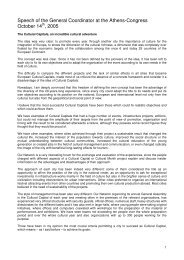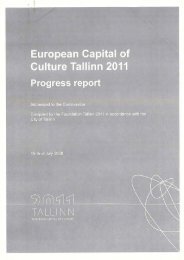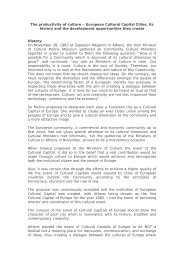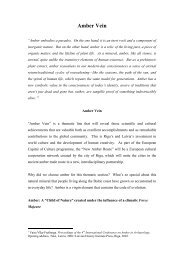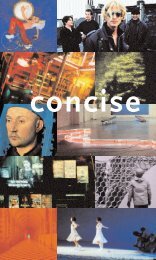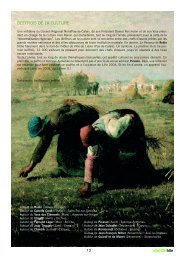patras 2006 - Documentation Centre on European Capitals of ...
patras 2006 - Documentation Centre on European Capitals of ...
patras 2006 - Documentation Centre on European Capitals of ...
You also want an ePaper? Increase the reach of your titles
YUMPU automatically turns print PDFs into web optimized ePapers that Google loves.
Λονδίνο το Μάιο του 1976, στο πλαίσιο τουEnglish Bach Festival.ΠερσέφασσαΗ Περσέφασσα, το πρώτο έργο του Ξενάκηγια σόλο κρουστά, γράφτηκε το 1969, κατόπινπαραγγελίας του Ιρανικού Φεστιβάλ των Τεχνώντου Σιράζ και του γαλλικού ΥπουργείουΠολιτισµού. Η πρώτη εκτέλεσή της έγινεστα ερείπια της αρχαίας Περσέπολης στις9 Σεπτεµβρίου της ίδιας χρονιάς και σηµείωσετεράστια επιτυχία: ο Ξενάκης είχε µιανέα παραγγελία για το φεστιβάλ του 1971 καιη Περσέφασσα χαιρετίστηκε από σύσσωµητη µουσική κοινότητα ως κοµµάτι αναφοράςστην εργογραφία για κρουστά.Περσέφασσα στην αρχαία Ελλάδα ήταν µίααπό τις πολλές ονοµασίες της Περσεφόνης,η οποία είχε συνδεθεί στην αρχαιοελληνικήµυθολογία µε τα φυσικά φαινόµενα του θανάτουκαι της αναγέννησης και την κυκλική διαδοχήτους. Στην Περσέφασσα του Ξενάκη οι µουσικοίκαι χωρικοί συµβολισµοί αναφορικά µε το µύθοτης Περσεφόνης βρίθουν, µε τον πλέον ακραιφνήαυτόν του αριθµού των εκτελεστών και τηςχωροθέτησής τους: το έργο είναι γραµµένογια έξι εκτελεστές (η Περσεφόνη περνούσεέξι µήνες πάνω στη γη και έξι µήνες στον κάτωκόσµο), οι οποίοι βρίσκονται γύρω από το κοινό,τοποθετηµένοι στις κορυφές ενός νοητούεξαγώνου. Με τον ίδιο τρόπο που «κυκλώνουν»οι εκτελεστές το κοινό, έτσι και στο τελευταίοµέρος του έργου ο ήχος των κρουστώνµεταφέρεται διαδοχικά από εκτελεστή σεεκτελεστή, δίνοντας την αίσθηση της αδιάλειπτηςκυκλικής κίνησής του και παραπέµποντας στηναέναη διαδοχή των φυσικών φαινοµένων πουσυνδέονται µε το µύθο της Περσεφόνης.Η προσέγγιση της Περσέφασσας που επιχειρείταισε αυτήν την εκτέλεση βασίζεται στα σηµείακλειδιά της σύνθεσης. Η ιδιαιτερότητα του έργουείναι ότι ο κάθε εκτελεστής παίζει σε διαφορετικάµουσικά µέτρα και µε διαφορετικό µετρονόµο.Κατόπιν αυτού επιβάλλεται ότι η πεµπτουσία τηςεκτέλεσης ορίζεται από την απόλυτη µαθηµατικήακρίβεια. Σε αυτήν την ερµηνευτική εκδοχή τηςΠερσέφασσας, µε πέντε ηχογραφηµένακινηµατογραφηµέναµέρη και έναν ζωντανόεκτελεστή, η απόλυτη «σύµπτωση» προσεγγίζεταικαι ο ακροατής βιώνει µια µοναδική οπτικοηχητικήεµπειρία.Ιάννης ΞενάκηςΣυνθέτης, αρχιτέκτονας και πολιτικός µηχανικός,ο Ιάννης Ξενάκης γεννήθηκε στις 29 Μαΐου του 1922,στη Βράιλα της Ρουµανίας. Συµµετέχοντας στηνΕθνική Αντίσταση, αναγκάστηκε να καταφύγει το 1947 στη Γαλλίαως πολιτικός πρόσφυγας. Εκεί δούλεψεγια έντεκα χρόνια στο πλευρό του Le Corbusierως αρχιτέκτονας, ενώ παρακολουθούσε ταυτόχρονα µαθήµατασύνθεσης µε τον Olivier Messiaen. Ισχυρός διανοητής καιµια από τις πιο ελκυστικές προσωπικότητες της σύγχρονηςµουσικής δηµιουργίας, ο Ιάννης Ξενάκης σφράγισε µε το έργο τουτη µουσική σκέψη του 20ού αιώνα και απέδειξε εµπράκτωςότι όρια µεταξύ των επιστηµών µεταξύ τους ή της επιστήµης καιτης τέχνης δεν υφίστανται. Μέλος της Γαλλικής Ακαδηµίας απότο 1986, τιµήθηκε µε πολλές άλλες διακρίσεις, στις οποίεςσυµπεριλαµβάνεται το Παράσηµο του Xρυσού Σταυρούτης Λεγεώνας της Tιµής της Γαλλικής Κυβέρνησης, καθώς καιτο Βραβείο Τεχνών και Ανθρωπιστικών Επιστηµών Κιότο.Πέθανε στο Παρίσι στις 4 Φεβρουαρίου 2001.∆ηµήτρης ∆εσύλλαςΠήρε το δίπλωµά του από τη Σχολή Κρουστών του ΩδείουΑθηνών στην ηλικία των 18 και συνέχισε τις σπουδές του στηΝέα Υόρκη και το Βερολίνο µε υποτροφίες από το ΜέγαροΜουσικής Αθηνών και το Κοινωφελές Ίδρυµα «ΑλέξανδροςΩνάσης». Με ευρύ σόλο ρεπερτόριο για κρουστά, στο οποίοσυµπεριλαµβάνονται και όλα τα έργα για σόλο κρουστά του ΙάννηΞενάκη, ο ∆ηµήτρης ∆εσύλλας έχει πραγµατοποιήσει σόλο ρεσιτάλκαι εµφανίσεις σε όλο τον κόσµο.Το 1995 ήταν ο «σολίστ της χρονιάς» στο Πανεπιστήµιο τηςΠολιτείας της Νέας Υόρκης. Το 2000 τιµήθηκε µε το Βραβείο τηςΈνωσης Κριτικών Μουσικής και Θεάτρου για την σολιστική τουπαρουσία και, επίσης, µε το Α' Βραβείο Σύνθεσης ΠρωτότυπηςΜουσικής για Xορό από το Υπουργείο Πολιτισµού. Έχειηχογραφήσει για τη Βαυαρική Ραδιοφωνία, για τη ∆ισκογραφικήΕταιρία BIS, για την Blue note, για την Ελληνική Ραδιοφωνίακαι το γαλλικό κανάλι Mezzo. Ο ∆ηµήτρης ∆εσύλλας διδάσκειστο Mουσικό Tµήµα του Ιονίου Πανεπιστηµίου και είναι δηµιουργόςκαι ιδρυτής των συνόλων κρουστών «Σείστρον» και «Τύµπανα».Άγης ΓυφτόπουλοςΟ Άγης Γυφτόπουλος γεννήθηκε στην Αθήνα. Σπούδασε µουσικήστο Εθνικό Ωδείο και θέατρο στη Σχολή του Εθνικού Ωδείουτου Θάνου Τράγκα. Εργάστηκε ως product specialist για τιςεταιρίες Roland και Akai. Συνεργάζεται ως δηµιουργικόςπαραγωγός µε studio ηχογράφησης, σε επίπεδα παραγωγής,ενορχήστρωσης, προγραµµατισµού midi καθώς και ηχογράφησηςκαι επεξεργασίας.Έχει συνθέσει µουσική για περισσότερες από 60 video ταινίες,διαφηµιστικά για ραδιόφωνο και τηλεόραση και έχει επιµεληθείενορχηστρώσεις και προγραµµατισµούς σε δισκογραφία.Η ιδιαίτερη ενασχόλησή του µε τον ήχο, όσον αφορά τη σύνδεσήτου µε τα συναισθήµατα, έχει ως αποτέλεσµα συνεργασίεςσε επίπεδο creative producer σε πολλές σύγχρονης µορφήςµουσικές δουλειές, σε δισκογραφία καθώς και µουσική για θέατροκαι χοροθέατρο.5657to Sylvio Gualda, who performed this piece forthe first time in L<strong>on</strong>d<strong>on</strong> <strong>on</strong> May 1976, in thescope <strong>of</strong> the English Bach Festival.PersephassaPersephassa, Xenakis’ first solo compositi<strong>on</strong>for percussi<strong>on</strong>s, was written in 1969 and wascommissi<strong>on</strong>ed by the Art Festival <strong>of</strong> Shirazand the French Ministry <strong>of</strong> Culture.The firstperformance was given at the ruins <strong>of</strong> AncientPersepolis <strong>on</strong> September 9 <strong>of</strong> the same yearand was a great success. Xenakis was <strong>on</strong>ce againinvited to the festival <strong>of</strong> 1971 and Persephassawas regarded a milest<strong>on</strong>e for compositi<strong>on</strong>sfor percussi<strong>on</strong>s by the entire music community.In Ancient Greece, Persephassa was <strong>on</strong>e <strong>of</strong>the many names <strong>of</strong> Perseph<strong>on</strong>e, who in AncientGreek mythology was c<strong>on</strong>nected to the naturalphenomena <strong>of</strong> death and rebirth and theirsequential cycle. In Xenakis’ Persephassa,themusical and the rustic symbolisms that referto the myth <strong>of</strong> Perseph<strong>on</strong>e are abundant, whilethe most precise characteristic is the number<strong>of</strong> performers and their arrangement in space:the piece is written for six performers(Perseph<strong>on</strong>e spent six m<strong>on</strong>ths <strong>on</strong> Earth and sixm<strong>on</strong>ths at the Underworld), who surround theaudience and are situated at the points <strong>of</strong> animaginable hexag<strong>on</strong>. In the same manner thatthe performers “encircle” the audience, duringlast part <strong>of</strong> the work the sound <strong>of</strong> percussi<strong>on</strong>sis sequentially transferred from <strong>on</strong>e performerto the next, giving the feeling <strong>of</strong> an uninterruptedcyclic moti<strong>on</strong> and making reference to theperpetual sequence <strong>of</strong> the natural phenomenac<strong>on</strong>nected to the myth <strong>of</strong> Perseph<strong>on</strong>e.The approach to Persephassa attempted in thisperformance is based <strong>on</strong> the key elements <strong>of</strong>synthesis.The work’s particularity is that eachperformer plays <strong>on</strong> different tempos and witha different metr<strong>on</strong>ome.Thus, the essence<strong>of</strong> the performance is absolute precisi<strong>on</strong>.In this performance versi<strong>on</strong> <strong>of</strong> Persephassa,with five recorded-filmed parts and a liveperformer, absolute “coincidence” is touchedand the audience lives a unique experience<strong>of</strong> image and sound.Iannis XenakisComposer, architect and civil engineer, IannisXenakis was born <strong>on</strong> May 29, 1922 in Braila,Romania. Having participated in the ResistanceMovement, in 1947 he was forced to escapeto France as a political refugee. In France,he worked as an architect for eleven years withLe Corbusier while simultaneously taking compositi<strong>on</strong> less<strong>on</strong>swith Olivier Messiaen. A great intellectual and <strong>on</strong>e <strong>of</strong> thebrightest pers<strong>on</strong>alities <strong>of</strong> modern music compositi<strong>on</strong>,Iannis Xenakis marked the music ideas <strong>of</strong> the 20th centurywith his works and proved that there are no bordersbetween scientific disciplines or between Science and Arts.Member <strong>of</strong> the French Academy since 1986, h<strong>on</strong>oured withmany distincti<strong>on</strong>s, including the Gold Cross Metal <strong>of</strong>the Legi<strong>on</strong> <strong>of</strong> H<strong>on</strong>our <strong>of</strong> the French Government, as wellas the Kyoto prize in Arts and Humanities. He died in Paris<strong>on</strong> February 4, 2001.Dimitris DesyllasObtained his diploma from the School <strong>of</strong> Percussi<strong>on</strong>s<strong>of</strong> the Athens C<strong>on</strong>servatory <strong>of</strong> Music at the age <strong>of</strong> 18and c<strong>on</strong>tinued his studies in New York and Berlin withscholarships from the Athens C<strong>on</strong>cert Hall (Megar<strong>on</strong>)and the “Alexandros Onassis Foundati<strong>on</strong>”. With a largerepertoire <strong>on</strong> percussi<strong>on</strong>s, which includes all <strong>of</strong> IannisXenakis’ solo compositi<strong>on</strong>s for percussi<strong>on</strong>s, he gave solorecitals and performances around the globe. In 1995,he was named “Soloist <strong>of</strong> the Year” at the New YorkUniversity. In 2000, he was h<strong>on</strong>oured with an Award fromthe Uni<strong>on</strong> <strong>of</strong> Music and Theatre Critics for his presenceas a soloist and w<strong>on</strong> the First Prize <strong>on</strong> the Compositi<strong>on</strong><strong>of</strong> Unique Dance Music from the Ministry <strong>of</strong> Culture.He made recordings for Barbaric Radio, BIS Discography,Blue Note, the Greek Radio and the French Channel, Mezzo.Dimitris Desyllas is a pr<strong>of</strong>essor at the Department<strong>of</strong> Music at the I<strong>on</strong>ian University and the creatorand founder <strong>of</strong> the percussi<strong>on</strong> ensembles “Seistr<strong>on</strong>”and “Timbana”.Agis GyphtopoulosAgis Gyphtopoulos was born in Athens. He studied musicat the Nati<strong>on</strong>al C<strong>on</strong>servatory <strong>of</strong> Music and theatre atthe School <strong>of</strong> the Nati<strong>on</strong>al C<strong>on</strong>servatory <strong>of</strong> Music <strong>of</strong> ThanosTrangas. He worked as a product specialist for the companiesRoland and Akai. He collaborates with recording studiosas creative producer <strong>on</strong> the producti<strong>on</strong>, orchestrati<strong>on</strong>, midiprogramming, as well as <strong>on</strong> the recording and processing.He has composed music for over 60 films, radio and televisi<strong>on</strong>commercials and has completed orchestrati<strong>on</strong>s andprogramming in discography. His unique activities with soundand how it c<strong>on</strong>nects with feelings resulted in collaborati<strong>on</strong>sas creative producer for many c<strong>on</strong>temporary music projectsin discography as well as music for theatre and dance theatre.



